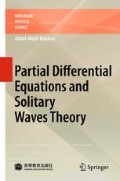Abstract
In 1844 the Scottish John Scott Russell was the first people to observe the solitary waves. As stated in Chapter 11, Russell called the bulge of water, that he observed, a “great wave of translation” [9]. The wave was traveling along the channel of water for a long period of time while still retaining its original identity.
Access this chapter
Tax calculation will be finalised at checkout
Purchases are for personal use only
Preview
Unable to display preview. Download preview PDF.
References
P.G. Drazin and R.S. Johnson, Solitons: an Introduction, Cambridge University Press, Cambridge, (1996).
U. Goktas and W. Hereman, Symbolic computation of conserved densities for systems of nonlinear evolution equations, J. Symbolic Comput., 24(5), 591–621, (1997).
W. Hereman, Shallow Water Waves and Solitary Waves. In: Encyclopedia of Complexity and Systems Science, Springer-Verlag, Heibelberg, (2009), to appear.
R. Hirota, The Direct Method in Soliton Theory, Cambridge University Press, Cambridge, (2004).
Y.A. Li and P.J. Olver, Convergence of solitary-wave solutions in a perturbed bi-Hamiltonian dynamical system. I. Compactons, and Peakons, Discr. Contin. Dyn. Syste., 3(3), 419–432, (1997).
Malfiet. W., Solitary wave solutions of nonlinear wave equations, Am. J. Phys., 60(7), 650–654, (1992)
E.J. Parkes and V.O. Vakhnenko, Explicit solutions of the Camassa-Holm equation, Choos Solitons Fractals, 26(5), 1309–1316, (2005).
P. Rosenau and J.M. Hyman, Compactorns: Solitons with finite wavelengths, Phys. Rev. Lett., 70(5), 564–567, (1993).
J.S. Sussell, Report on Waves: 14th Meeting of the British Association for the Advancement of Science, John Murray, London, 311-390, (1844).
A.M. Wazwaz, Peakons, kins, compactons and solitary patterns solutions for a family of Camassa-Holm equations by using new Hyperbolic schemes, Appl. Math. Comput., 182(1), 412–424, (2006).
N.J. Zabusky and M.D. Kruskal, Interaction of solitons incollisionless plasma and the recurrence of initial states, Phys. Rev. Lett., 15(6), 240–243, (1965).
Author information
Authors and Affiliations
Rights and permissions
Copyright information
© 2009 Higher Education Press, Beijing and Springer-Verlag Berlin Heidelberg
About this chapter
Cite this chapter
Wazwaz, AM. (2009). Solitary Waves Theory. In: Partial Differential Equations and Solitary Waves Theory. Nonlinear Physical Science. Springer, Berlin, Heidelberg. https://doi.org/10.1007/978-3-642-00251-9_12
Download citation
DOI: https://doi.org/10.1007/978-3-642-00251-9_12
Published:
Publisher Name: Springer, Berlin, Heidelberg
Print ISBN: 978-3-642-00250-2
Online ISBN: 978-3-642-00251-9
eBook Packages: Physics and AstronomyPhysics and Astronomy (R0)

